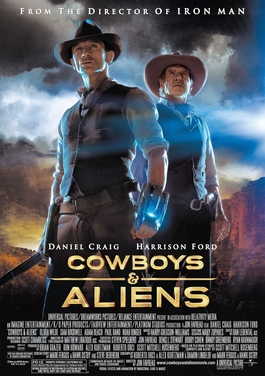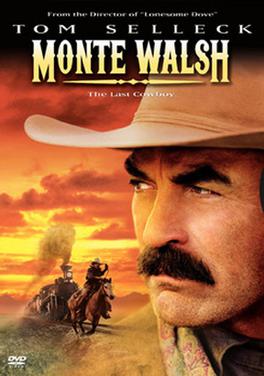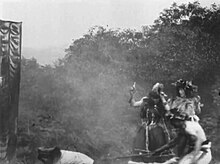
The Western is a genre of fiction typically set in the American frontier between the California Gold Rush of 1849 and the closing of the frontier in 1890, and commonly associated with folk tales of the Western United States, particularly the Southwestern United States, as well as Northern Mexico and Western Canada.

The Great Train Robbery is a 1903 American silent film made by Edwin S. Porter for the Edison Manufacturing Company. It follows a gang of outlaws who hold up and rob a steam locomotive at a station in the American West, flee across mountainous terrain, and are finally defeated by a posse of locals. The short film draws on many sources, including a robust existing tradition of Western films, recent European innovations in film technique, the play of the same name by Scott Marble, the popularity of train-themed films, and possibly real-life incidents involving outlaws such as Butch Cassidy.

The Searchers is a 1956 American epic Western film directed by John Ford and written by Frank S. Nugent, based on the 1954 novel by Alan Le May. It is set during the Texas-Native American wars, and stars John Wayne as a middle-aged Civil War veteran who spends years looking for his abducted niece, accompanied by his adopted nephew. It was shot in VistaVision on Eastmancolor negative with processing and prints by Technicolor.

Wild and Woolly is a 1917 American silent Western comedy film which tells the story of one man's personal odyssey from cowboy-obsessed Easterner to Western tough guy. It stars Douglas Fairbanks, Eileen Percy, Walter Bytell and Sam De Grasse. The film was adapted by Anita Loos from a story by Horace B. Carpenter and was directed by John Emerson.
The following is an overview of the events of 1899 in film, including a list of films released and notable births.
The following is an overview of the events of 1897 in film, including a list of films released and notable births.
The Mitchell & Kenyon film company was a pioneer of early commercial motion pictures based in Blackburn in Lancashire, England, at the start of the 20th century. They were originally best known for minor contributions to early fictional narrative film and Boer War dramatisation films, but the discovery in 1994 of a hoard of film negatives led to restoration of the Mitchell & Kenyon Collection, the largest surviving collection of early non-fiction actuality films in the world. This collection provides a fresh view of Edwardian era Britain and is an important resource for historians.
The heist film or caper film is a subgenre of crime films and the caper story, focused on the planning, execution, and aftermath of a significant robbery.

The revisionist Western is a sub-genre of the Western film. Called a post-classical variation of the traditional Western, the revisionist subverts the myth and romance of the traditional by means of character development and realism to present a less simplistic view of life in the "Old West". While the traditional Western always embodies a clear boundary between good and evil, the revisionist Western does not.

Nevada Smith is a 1966 American Western film directed by Henry Hathaway and starring Steve McQueen, Karl Malden, Brian Keith, Arthur Kennedy and Suzanne Pleshette. The film was made by Solar Productions in association with and released by Paramount Pictures. It was McQueen's first theatrical Western, five years after his TV series, Wanted Dead or Alive, ended.
James Kenyon was a businessman and pioneer of cinematography in Blackburn, Lancashire, England.

Actuality film is a non-fiction film genre that uses footage of real events, places, and things, in a similar way to documentary film. Unlike documentaries, actuality films are not structured into a larger narrative or coherent whole. In practice, actuality films preceded the emergence of the documentary. During the era of early cinema, actualities—usually lasting no more than a minute or two and usually assembled together into a program by an exhibitor—were just as popular and prominent as their fictional counterparts. The line between "fact" and "fiction" was not as prominent in early cinema as it would become once documentaries became the predominant non-fiction filmmaking form. Actuality as a film genre is related to Still photography.

Weird West is a term used for the hybrid genres of fantasy Western, horror Western and science fiction Western. The term originated with DC's Weird Western Tales in 1972, but the idea is older as the genres have been blended since the 1930s, possibly earlier, in B-movie Westerns, comic books, movie serials and pulp magazines. Individually, the hybrid genres combine elements of the Western genre with those of fantasy, horror and science fiction respectively.

Wild West shows were traveling vaudeville performances in the United States and Europe that existed around 1870–1920. The shows began as theatrical stage productions and evolved into open-air shows that depicted romanticized stereotypes of cowboys, Plains Indians, army scouts, outlaws, and wild animals that existed in the American West. While some of the storylines and characters were based on historical events, others were fictional or sensationalized.

James Young Deer, also known as J. Younger Johnson or Jim Young Deer, was actually born James Young Johnson in Washington, D.C. Although he was identified in the early Hollywood trade paper Moving Picture World as of the Winnebago Tribe of Nebraska, his ancestry is of the Nanticoke people of Delaware. He became an early film actor, director, writer, and producer. He is believed to be the first Native American filmmaker/producer in Hollywood. Together with his wife and partner Lillian St. Cyr, Winnebago, the couple were labeled an "influential force" in the production of one-reel Westerns during the first part of the silent film era. Their films, along with several others of the silent era, were notable for portraying Native Americans in a positive light.

Cowboys & Aliens is a 2011 American science fiction Western action film directed by Jon Favreau and starring Daniel Craig, Harrison Ford, Olivia Wilde, Sam Rockwell, Adam Beach, Paul Dano, and Noah Ringer. The film is based on the 2006 Platinum Studios graphic novel of the same name created by Scott Mitchell Rosenberg. The plot revolves around an amnesiac outlaw (Craig), a wealthy cattleman (Ford), and a mysterious traveler (Wilde) who must ally to save a group of townspeople abducted by aliens. The screenplay was written by Roberto Orci, Alex Kurtzman, Damon Lindelof, Mark Fergus, and Hawk Ostby, based on a screen story by the latter two along with Steve Oedekerk. The film was produced by Brian Grazer, Ron Howard, Kurtzman, Orci, and Rosenberg, with Steven Spielberg and Favreau serving as executive producers.

Monte Walsh is a 2003 American Western television film directed by Simon Wincer and starring Tom Selleck, Isabella Rossellini, and Keith Carradine. It was adapted from Jack Schaefer's 1963 novel Monte Walsh. This film is a remake of the 1970 Monte Walsh film that starred Lee Marvin.

The Western is a film genre defined by the American Film Institute as films which are "set in the American West that [embody] the spirit, the struggle, and the demise of the new frontier." Generally set in the American frontier between the California Gold Rush of 1849 and the closing of the frontier in 1890, the genre also includes many examples of stories set in locations outside the frontier – including Northern Mexico, the Northwestern United States, Alaska, and Western Canada – as well as stories that take place before 1849 and after 1890. Western films comprise part of the larger Western genre, which encompasses literature, music, television, and plastic arts.










